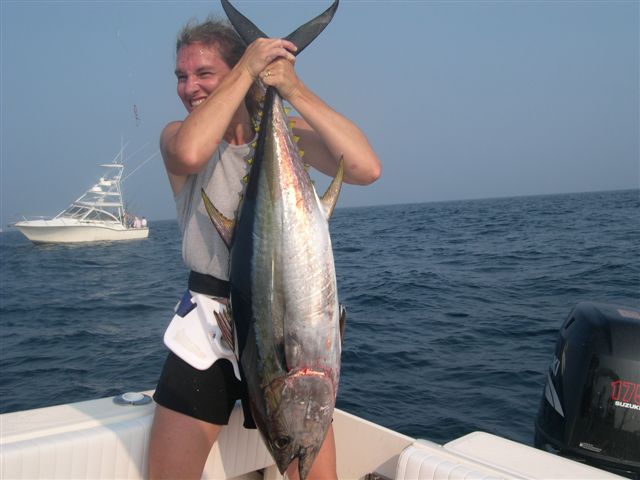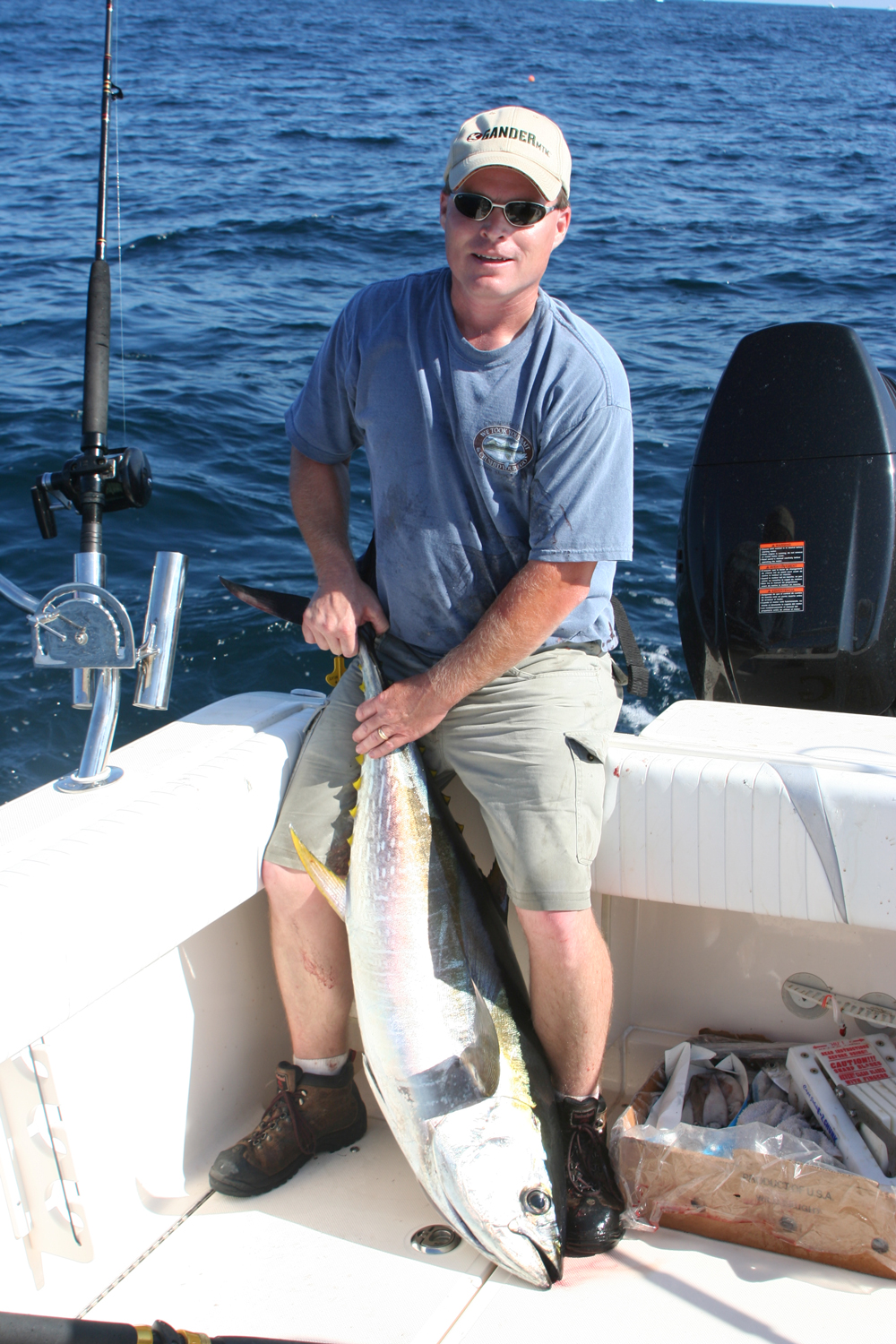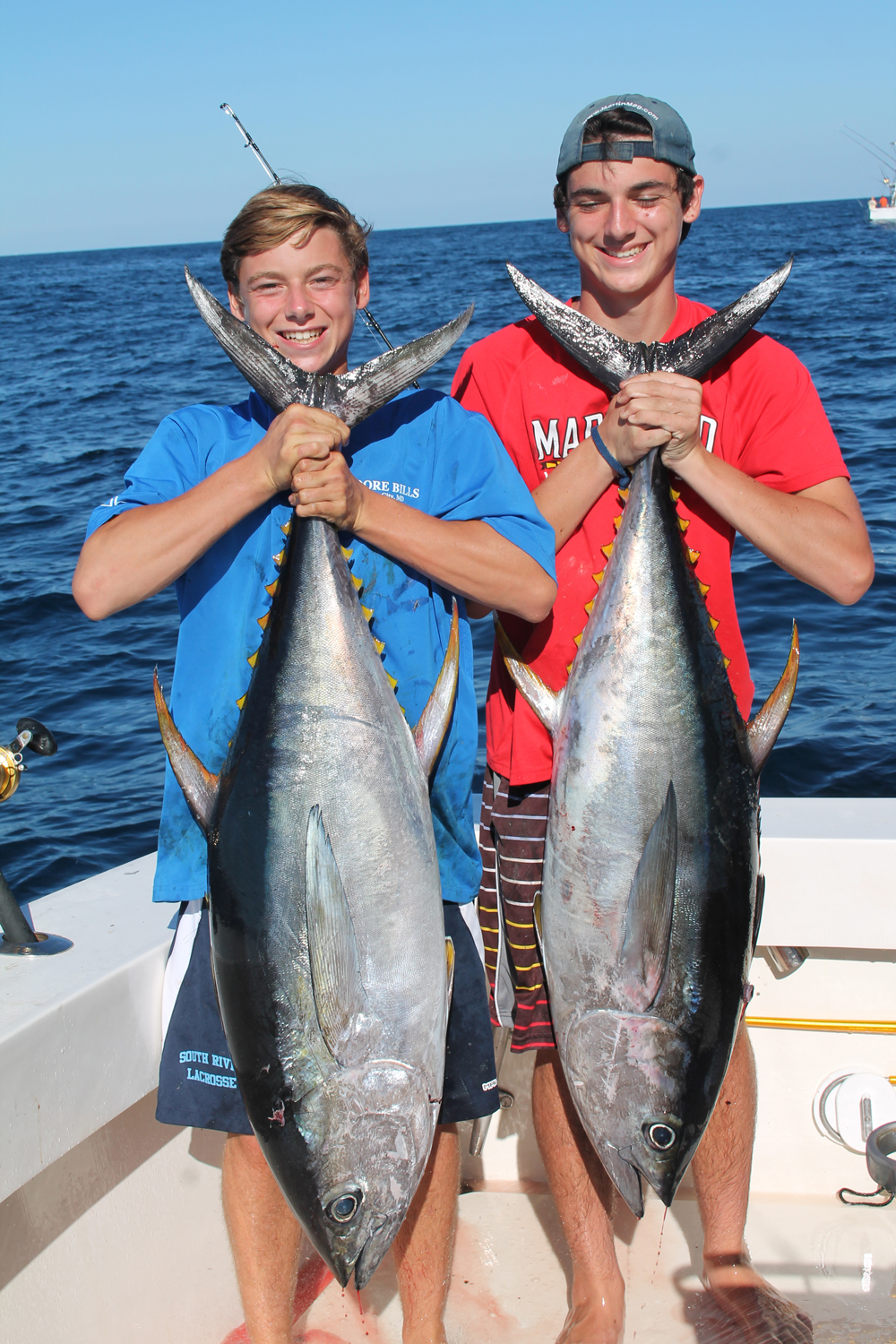Those who know how to fish offshore in the Mid-Atlantic region are quite familiar with tuna chunking. Sure, some call it “going over to the dark side.” Others say it’s simplistic, boring, and messy, while trolling is much more of an art form. In fact, many of the captains running out of
Tuna Candy
The concept behind chunking is pretty darn straightforward: hack up a bunch of butterfish, and toss handfuls of fish bits over the side to attract tuna. But there are a lot of details that go into this seemingly simple process which will result in improved catches. First, the bait: You’ll need a 25-lb. flat of butterfish to keep an average chunk line going for about four hours. If you plan on a full day of fishing, two flats will be needed. All too often, you’ll be sold sub-standard butterfish. Ensure the quality by pulling the top off the box before you leave the store, and eyeballing the baits. Chalky yellow spots (rot, which usually forms around the dorsal and anal fins first) indicates poor quality. Another thing to look for is sunken, dried out eyes, which also indicates poor quality. Size of the baits is less important, and as long as there are enough butterfish the size of your palm to use as baits, tiny ones still make fine chunks.
Next, add in a box of sardines. It’s good to mix some in with the butterfish chunks but more important is having the sardines for baits; at times the tunas just seem to want them more than the butterfish.
Now that you have your baitfish, it’s time to turn them into chunks. But if you bought them at 5:00 in the morning, tossed them into your cooler of ice, and cruised out to the fishing grounds, those fish will be as hard as a rock and you won’t be cutting anything for a few hours yet—make sure you open a flat and give it a blast from the washdown hose to start it thawing, before you even leave the dock. Then, you can use one of three methods to cut the fish: the knife method, the shear method, or the chopper method. Most anglers simply put a few butterfish onto a cutting board, slice them into chunks the size of a pocket lighter, push the chunks into a bucket, and grab some more fish to chop. Using this method, it will take about half an hour to go through a quarter of a flat, at which point the guy slicing butterfish usually:
- Pukes, from breathing in fish goo for too long in rough seas
- Cuts himself or pokes himself with a butterfish fin and quits
- Gets a blister, and asks someone else to take over.
Yes, chopping butterfish in this manner is a real pain in the butt.

Anglers with more experience are apt to carry a large pair of steel shears on the boat, grip a butterfish by the head, and hold it over the bucket as they slice the fish into chunks. This works better than a knife, but is still a pain in the butt. There are also some commercially-made butterfish chunkers, which look and work more or less like huge egg slicers that fit over the top of a five-gallon bucket. These do get the job done far more easily and quickly than a knife or shears.
So — you now have a bucket full of chunks. What next? Cut some baits. Traditional theory holds that for yellowfin you should take the head and tail off the butterfish, turning the body into an extra-large chunk, and for bluefin you should use the entire butterfish. (Read Bluefin Bonanza to learn more about targeting bluefin tuna in specific). I’ve found both and or either can be successful on any given day, and at times, both bluefin and yellowfin seem to prefer a regular small chunk to larger offerings. In either case, do your best to hide your hook in the bait.
Speaking of hooks – 8/0 is about the right size, and rig it to a five foot fluorocarbon leader. Leader size can vary radically, because tuna can be finicky when it comes to heavy leaders. When possible, 80-lb or 100-lb test fluorocarbon can be used and it gives you the ability to muscle the fish around pretty well. But often tuna won’t touch heavy leaders, and you may have to scale all the way down to 30-lb test before fish start taking it without hesitation. Case in point: one day a few seasons back we chunked a large school of 40- to 80-lb bluefin off of a scalloper, and held them next to our boat most of the day. We offered baits on rigs starting at 100-lb. test, then dropped them to 80, 60, and so on. Until we tied on 30-lb test, the fish swam up our baits then veered away at the last second, every time.
So — how do you know what to use on any given day? Most captains start out with the heavy stuff, and if bites don’t come quickly, set out a line or two with light leaders. If those lines get taken, they will switch the rest of the gear accordingly. TIP: Always use circle hooks with light leaders, so you snag the fish in the corner of the jaw. J-hooks often get caught deeper in the fish’s mouth or throat, leaving the light line subject to chaffing from the tuna’s teeth.
Once you thread a butterfish or a chunk onto the hook, drop it over the side and make sure it’s not spinning. If it does spin, rip it off and rig a new bait. The disadvantage of having no swivel on your line is that a single spinning bait can put enough line twist into your reel to drive you crazy. Even if you have to re-bait five times before one comes out right, do it.
The average chunker secures the leader to their main line by tying on a double line, then a swivel, and then tying the leader to the swivel. This works, but it means you’ll have to wire the fish at the end of the fight. In my experience far too many fish are lost during this process, so I eliminate wiring entirely by tying a loop in the end of my leaders by way of a spider hitch, then connecting via loop-to-loop with the doubled line. This rig can be reeled through the rod guides without a problem, eliminates wiring entirely, and has a lower failure rate than tying directly to a swivel.

The Bait Debate
Chunking can be done at anchor, or on the drift. At anchor is usually more effective, but when the wind and current conspire to push your baits up against your anchor line, drifting is mandatory. Either way, keep the chunks flowing steadily. Toss out a handful, watch until they disappear from view, then toss out another. You can sweeten the slick by adding a dose of menhaden oil to your chunk bucket, which not only helps draw in fish but also smoothes down the surface ripples, making it easier to spot fish that swim into your chunk line.
Where to place your baits in the water column is one of the most important aspects of chunking. Bottom line: you will catch fish from the surface baits, mid-depth baits and bottom baits, at different times on different days. Trying to predict which will be the most effective ahead of time is impossible, so you should always try to cover all the bases. When one particular depth seems to be the productive one for that given day, switch your other rigs around accordingly. Start off by setting some lines about 10’ off the bottom (this one often produces when big bluefin are around) some at mid-depth, and one or two near the surface.
Setting baits is all well and good, but often they won’t get taken half as much as a “stripper” bait. Strippers are baits you rig with no weight or float of any sort. When you lower one over the side, throw in an extra-large handful of chunks, trying to scatter them in the water all around your bait. Then set the rod into a holder, in freespool, with the clicker on. Before the bait sinks enough to cause tension, grab your line just beyond the rod tip, strip out five or six feet of line, and drop it on the water’s surface so that your bait sinks unrestricted. As the line comes close to getting tight repeat the process, and keep it up for five or 10 minutes. Fished in this way, the bait will sink through the water column at the same rate as the chunks, and will look as natural as possible to the fish. Whether you get hit on a stripper, mid-depth or deep line, as soon as a fish takes the bait throw the reel into strike and smoothly start reeling, without any hookset—these fish are moving so fast that a yank on the rod has little to no effect, other than to occasionally jiggle the hook free.

That sums up the basics of chunking, but what about those nay-sayers, who are always looking down on chunking as compared to trolling for tuna? Hey — some of us think chunking is the REAL art form, stimulating far more creativity and requiring far more talent than trolling. Just look at the swirly, red-brown-green stains you can make on your boat. As you toss the chunks overboard try bouncing them off your crewmember’s white T-shirts, and you’ll conjure up Rorschach-like patterns no troller has ever dreamed of. And sometimes chunking results in a cockpit running ankle-deep in tuna blood, which then dyes your white High-tops red—the highest art form of them all.